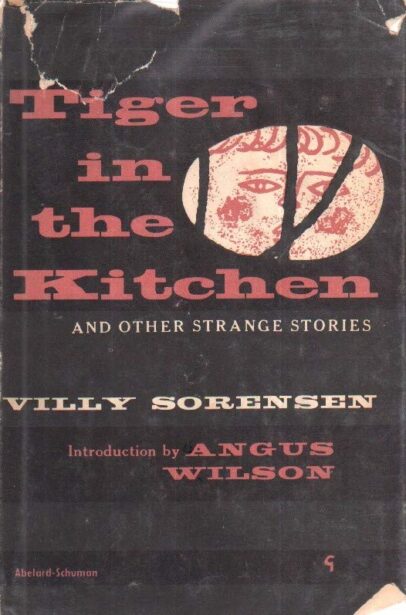 By VILLY SORENSEN (Abelard-Schuman; 1957)
By VILLY SORENSEN (Abelard-Schuman; 1957)
Not a great book, but an interesting example of how fiction ages. These “strange stories” by a (then) youthful Dane were apparently quite startling back in 1957, particularly “The Tigers,” a novella-length exercise in tersely rendered absurdism whose tone is set quite adroitly by the opening paragraph: “Two brothers had only just left home when they each at the same time received a telegram from their mother. It said: “Return immediately, tiger in the kitchen.”” In his introduction, in which all the expected literary comparisons are bandied about (Franz Kafka is the most frequently invoked name, followed by Thomas Mann), Angus Wilson proclaims “The Tigers” the book’s “most outstanding” piece.
These days, however, TIGER IN THE KITCHEN’S premiere tale is the gut-freezing “Child’s Play” (a.k.a. “Just a Prank”), which according to Angus Wilson “speaks for itself, perhaps too horribly for some readers.” That may have been how it seemed back in 1957, but now, after nearly 70 years, “Child’s Play” stands as a disturbing foreshadowing of the type of underage mayhem that in our modern age is taken as a given.
The situation: two young boys happen upon another with a nasty foot wound. Recalling an uncle who had an injury into which “a lot of animals had crawled…These animals were so small you couldn’t even see them” and resulted in an amputation, the boys conclude that their wounded companion needs a similar treatment. The ensuing drama is pulled off with a distinctly morbid sense of humor, although what ultimately registers is a sense of profound horror and revulsion, rendered all the more acute because the whole tale is so horrifically convincing (Ramsey Campbell admittedly put together an entire anthology, 1988’s FINE FRIGHTS, as an excuse to reprint “Child’s Play”).
Of the other stories, “The Two Twins” is about twin brothers who are identical in every aspect, and the tragedy that occurs when a woman comes between them—it’s not unlike a more sardonic and black humored take on TWINS (and its film adaptation DEAD RINGERS). The enjoyably outlandish “The Strange Tree” toys with subject matter filched from “Jack and the Beanstalk,” with a boy becoming stuck in an impossibly tall tree and the kid’s gardener father attempting to find a way to get his son down.
Less successful tales, of which this book unfortunately contains several, include “The Concert,” another absurdist novella. About the construction of a magical concert hall in a mythical city, it’s an ambitious mixture of surrealism, science fiction and visionary fantasy that doesn’t come off, with the tale’s varying components cancelling each other out. A similar problem is evident in “Two Legends,” in which Sorensen attempts to (perhaps) spoof Christianity in the form of two mock-Biblical tales, but the religious ruse is never very convincing, much less compelling. “The Murder Case” attempts to wreak similar havoc on the whodunit model, but the highly observational, detail-heavy results are rambling and dull.
On balance this is a highly uneven and only partially satisfying collection, even if it seemed like much more in 1957. Nonetheless, TIGER IN THE KITCHEN contains one rarely reprinted masterpiece—“Child’s Play”—that by itself nearly renders the book a must-buy.
